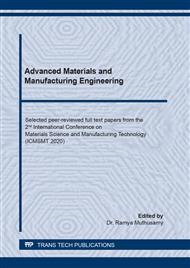[1]
R. Iyer and H. Pickering, Analysis of hydrogen evolution and entry into metals for the discharge-recombination process,, J. Electrochem. Soc. 136 (1989) 2463-2470.
DOI: 10.1149/1.2097429
Google Scholar
[2]
S. Dey, A.K. Mandhyan, S.K. Sondhi and I. Chattoraj, Hydrogen entry into pipeline steel under freely corroding conditions in two corroding media,, Corros. Sci. 48 (2006) 2676 -2688.
DOI: 10.1016/j.corsci.2005.10.003
Google Scholar
[3]
T. Casnova, J. Crousier, The influence of an oxide layer on hydrogen permeation through steel,, Corros. Sci. 38 (1996) 1535-1544.
DOI: 10.1016/0010-938x(96)00045-5
Google Scholar
[4]
C.H. Tseng, W.Y. Wei and J.K. Wu, Electrochemical methods for studying hydrogen diffusivity, permeability in AISI 420 and 430 stainless steels,, Materials Sci. Technol. 5 (1989) 1236 -1239.
DOI: 10.1179/mst.1989.5.12.1236
Google Scholar
[5]
P. Manolatos, M. Jerome, C. Duret-Thual and J. Le Coze, The electrochemical permeation of hydrogen in steels without palladium coating. Part I: Interpretation difficulties,, Corros. Sci. 37 (1995) 1773-1783.
DOI: 10.1016/0010-938x(95)00079-y
Google Scholar
[6]
M. Yan and Y. Weng, Study on hydrogen absorption of pipeline steel under cathodic charging,, Corros. Sci. 48 (2006) 432-444.
DOI: 10.1016/j.corsci.2005.01.011
Google Scholar
[7]
H.J. Grabke and E. Riecke, Absorption and diffusion of hydrogen in steels,, Mater. Technol. 34 (2000) 331–342.
Google Scholar
[8]
S.J. Kim and K.Y. Kim, A review of corrosion and hydrogen diffusion behaviors of high strength pipe steel in sour environment,, J. Weld Join 32 (2014) 443–450.
DOI: 10.5781/jwj.2014.32.5.13
Google Scholar
[9]
C.F. Dong, Z.Y. Liu, X.G. Li and Y.F. Cheng, Effect of hydrogen charging on the susceptibility of X100 pipeline steel to hydrogen induced cracking,, Int. J. Hydrogen Energy 34 (2009) 9879-9884.
DOI: 10.1016/j.ijhydene.2009.09.090
Google Scholar
[10]
A.J. Haq, K. Muzaka, D.P. Dunne, A. Calka and E.V. Pereloma, Effect of microstructure and composition on hydrogen permeation in X70 pipeline steels,, Int. J. Hydrogen Energy 38 (2013) 2544-2556.
DOI: 10.1016/j.ijhydene.2012.11.127
Google Scholar
[11]
H.B. Xue and Y.F. Cheng, Characterization of inclusions of X80 pipeline steel and its correlation with hydrogen- induced cracking,, Corros. Sci. 53 (2011) 1201-1208.
DOI: 10.1016/j.corsci.2010.12.011
Google Scholar
[12]
S.J. Kim, and K.Y. Kim, A Review of corrosion and hydrogen diffusion behaviors of high strength pipeline steel in sour environment,, J. Welding and Joining 32 (2014) 13-20.
DOI: 10.5781/jwj.2014.32.5.13
Google Scholar
[13]
G.T. Park, S.U. Koh, G. Jung and K.Y. Kim, Effect of microstructure on the hydrogen trapping efficiency and hydrogen induced cracking of line pipe steel,, Corros. Sci. 50 (2008) 1865-1871.
DOI: 10.1016/j.corsci.2008.03.007
Google Scholar
[14]
J.H. Luo, L. Zhang, L. Li, F. Yang, W. Ma, K. Wang and X. Zhao, Electrochemical corrosion behaviors of the X90 linepipe steel in NS4 solution,, Natural Gas Industry, B 3 (2016) 346-351.
DOI: 10.1016/j.ngib.2016.12.011
Google Scholar


